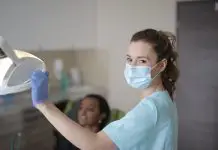Dentist’s chairs, or dental units as they are known in jargon, are work stations that include not only the seat for the patient, but also some of the devices the dentist needs to do their job, from handpieces to turbines and suction hoses.

The chair is therefore the heart of a dental practice, but it also represents an important vehicle for infection, for both patients and dentists and their staff. Blood, saliva and breath, which are inevitable when working on patient’s teeth, can contaminate equipment and pose a threat to safety very quickly, making it essential to perform thorough and effective disinfection of all objects and surfaces several times a day.
Appropriate and meticulous use of cleaning procedures, together with the use of specific products for dental instruments sterilization and impression disinfection, allows dentists, assistants and hygienists to work with peace of mind, and provides the patient with a clean and comfortable chair to sit in.

Dental units can be vehicles for the fungi, bacteria and harmful protozoa that are most likely to circulate, especially in the chair’s plumbing and suction unit. In this setting, infections are caused by a great many pathogens in a number of different ways. The high and rapid patient turnover increases the risk of the spread of infection, especially when they undergo particularly invasive procedures.
Infection travels through both direct means (direct contact with the source of infection, for example direct contact with the blood of an infected patient) and indirect means (contact with infected blood through the surgical instruments used). Droplets in particular can cause infection both directly (droplets of saliva that are transferred directly from the patient to the mucosae of the practitioner) and indirectly (saliva droplets that settle on a surface that is subsequently touched). Infection can also be airborne (light droplets that remain suspended in the air for prolonged periods). In dentistry, the risk of infection is higher due to the greater contact with potentially infected body fluids, especially inside the plumbing and suction unit that are essential for the operation of the instruments and the removal of waste. Following suction unit cleaning and disinfection protocols does not always help to prevent the formation of biofilm composed of clusters of microorganisms of various types, which proliferate in limescale deposits, and are typical of environments in which water and solid residues circulate; and it is precisely inside this biofilm that pathogens can hide.

Cleaning and disinfection of all parts of the unit is essential, especially with regard to the plumbing and suction units. We will therefore focus on the steps of a correct daily disinfection protocol for dental units, aimed at drastically reducing the proliferation and accumulation of bacteria and pathogens.
The following operations are performed at the start of the day:
- Flushing the suction hoses with a good quality disinfectant
- Rinsing the instruments with water
With each new patient:
- Wiping, cleaning and decontaminating the surfaces
- Rinsing each instrument with water
- Flushing the suction hoses with good quality disinfectant
At the end of the day:
- Flushing the suction hoses with a good quality disinfectant
- Rinsing each instrument with water
- Cleaning the spittoon drain filter
- Emptying and cleaning the suction system filter
As we have seen, the application of a dental chair cleaning protocol requires attention, constancy and disinfectants developed specifically for dental practice use, products with characteristics that vary in accordance with specific requirements. Non-aggressive products with a sustained action are ideal for dental unit disinfection.









































